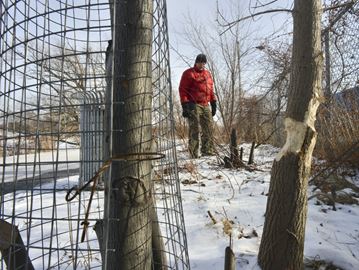S2492
Removes statutory limitation on number of permits that may be issued by Division of Fish and Wildlife for the taking of beaver. The Division of Fish and Wildlife may issue up to and not exceeding 200 permits in any one calendar year
In addition to the general permitting authority provided by this section, the Division of Fish and Wildlife may, in its discretion, issue permits to owners or lessees of land to control beavers that are destroying [said] the property.
Beaver trapping could be expanded in New Jersey
What might be good news for trappers across New Jersey could also be bad news for the state’s beaver population. Legislation under consideration in the state Senate would eliminate the 200-limit cap on beaver trapping licenses. The legislation, though, calls for a limit of five beavers per permit and sets fines for violating the measure starting at $100, with a $200 maximum.
Supporters of the bill say it’s necessary to help the state manage beaver populations. The Control Operators Association estimates New Jersey has around 10 million to 15 million beavers, mostly concentrated in the northwest part of the state.
Wow. That’s AMAZING 15,000,000 beavers in a small section of a state the size of a postage stamp is one big problem! I’m sorry to say it, but this explosive problem won’t be fixed by writing a few more permits. 15,000,000 beavers in a state with 1300 square miles of water is a national disaster. It’s going to have to be solved by military strikes and the navy. The population of HUMANS in new Jersey n the 2013 census was only around 8.9 million. In order for that to be true you’d have to have over 11,000 beaver per square mile of water. That’s pretty crowded!
Like penguin colony crowded.

Or I guess you might be exaggerating. You know, flat out lying to justify your case so that this reach-around for your trapper friends seems justified. Or maybe the reporter wrote down the facts wrong. We know that never (always) happens.
If all this is sounding vaguely familiar, it should. Because the honorable Mr. Sweeney has been trying to ram this bill through the legislature for as long as I’ve been on the beaver beat. Here’s what I wrote about it in 2013.
Congress may be unable to pass a background check, a budget or a resolution for more stalls in the ladies restroom, but a bipartisan group of state senators in New Jersey has decided that the old rule declaring that the division of fish and wildlife can only issue 200 depredation permits for beavers per year is insufficient to the numbers of beavers that need killing in the state. Remember that the state is the fifth smallest in the entire country and about the size of a postage stamp.
The white hats are on the case, and sent me an alert earlier in the week even before this hit the papers. Hopefully they’ll be able to slow this down, or just challenge the lies enough to make one legislator turn tail (so to speak). The whole thing is on the floor monday morning.
Monday January 12 Senate Environment and Energy Meeting 10:00 AM Committee Room 10, 3rd Floor, State House Annex, Trenton, NJ Chair: Sen. Smith, BobThe paper points out that trapper Frank Speicker doesn’t want us to worry.
Spiecker added that, if managed well, beavers can be a renewable resource. Plus, he said, they’re not easy to trap, frequently outsmarting trappers.
“Sometimes they win completely,” he said.
Ahem.
If you’re not quite reassured, you can send your letters here to the chair and vice chair of Environment and Energy here. And then let’s just sit back and enjoy the thought of what it would mean to really have 1500000 beavers in every state.









 Back in September Suzanne Fouty sent me an article from the
Back in September Suzanne Fouty sent me an article from the  When we think of climate change, the idea seems so big and unfixably hopeless that most stop thinking very quickly. Mary Wood challenged that lethargy dramatically with her dynamic work, and it’s even more exciting to hear described in person. Find an hour in your day for this program and watch the entire thing. Really. It’s that good. But here are some money quotes from the transcript that will give you the basic platform.
When we think of climate change, the idea seems so big and unfixably hopeless that most stop thinking very quickly. Mary Wood challenged that lethargy dramatically with her dynamic work, and it’s even more exciting to hear described in person. Find an hour in your day for this program and watch the entire thing. Really. It’s that good. But here are some money quotes from the transcript that will give you the basic platform.



































